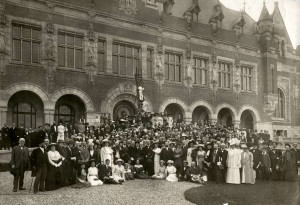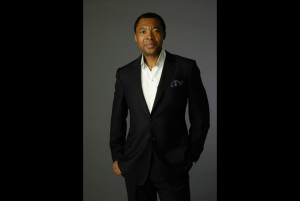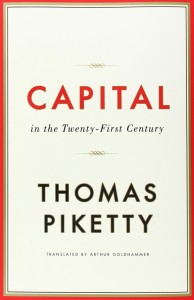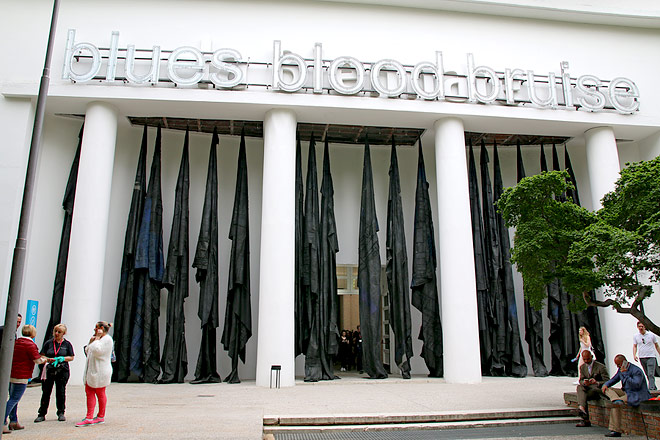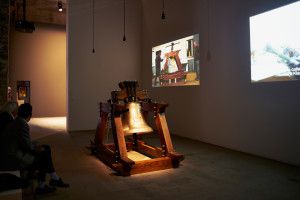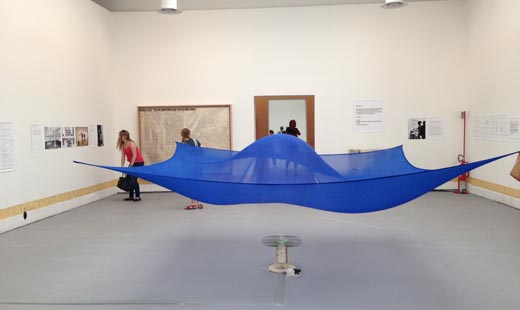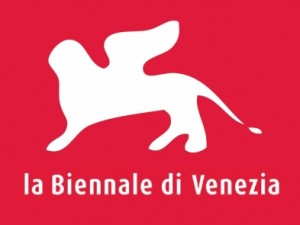
Via his metals, markets and connections mister Carnegie gave back by contributing to the constructing of four buildings dedicated to knowledge and peace – of which the Peace Palace in The Hague is one. However his philanthropy is much appreciated, it was not enough to steer the future towards peace and prosperity for all. Still his example is a nobel one. Alike Enwezor he strived to make the world more multiplicit and inclusive by showing beauty in the rubble, making statements in between motives and provide wealth in multitude.
Vincent van Velsen on Enwezor’s Venice Biennial.
Civilized Futures
On Peace, Falsifiability and Civilization
When the Peace Palace in The Hague celebrated its grand opening in 1913, none of the present politicians, aristocrats or royals would have ever imagined to be involved in an armed conflict a year later. The ouvertural festivities were meant to signify a moment in time that no collective quarrels were solved by killing each other, and to be an indication of a peaceful future that was smiling at all nations alike. Still, even when the armed encounters initiated, none of the aforementioned people in power imagined it to ever become a milestone in history with such intensity and duration; leaving over eight million death and at least equal amounts displaced or, physically and mentally injured. Here, the human positivity – or inability – is met. We are not too well equipped in predicting the future, or in developing a sense for what is ahead of us, or in reaching a long-term state of non-violent existence. Expectancies tend to be positive until the fan is hit – falling is considered flying until the ground is reached. We do not have to look as far back as to the opening of the Peace Palace but can use the sudden strike at 9/11, the unimaginable collapse of Lehman Brothers or the unexpected occurrence of ISIS as close points of indication of this human impossibility to predict.
Paul Klee, Angelus Novus, 1920.
Exactly this blindness towards the signs, or omens – and towards the future in general – was addressed by Walter Benjamin in his account relating to Paul Klee’s Angelus Novus (1920). This extensively utilized and referenced example in which Benjamin describes a person facing the piles of history continuously arising, while being moved towards the future backwards, unable to see what is to come, was taken by Okwui Enwezor as the starting point of his Venice Biennial (2015). We are unaware about what is yet to come. The knowledge and experience of history lies in front of us. But the knowledge and readings on what has occurred, on what we know ‘already’ is an unstructured heap that influences our position in the future. Therefore, Enwezor claims, it is highly desirable to extend ones scope, pursue a maximum amount of positions (knowledge) and remain open to as many perspectives possible. All, to gain as much as an understanding of both historic and present affairs. A similar argument he already conferred in his statements concerning Documenta 11 (2002). Also then, Enwezor plead in favor of addressing as many points of view as possible. Somewhat remarkable is that both exhibitions happened shortly after attacks that were claimed by fundamental extremist: respectively the 9/11 airplane bombings and the Paris Charlie Hebdo massacre.
Both events are explicitly mentioned by Enwezor, not so much in a one-sided condemning manner; but in a way in which he warns for lurking extremism within the Western world – as shortsighted reactions on both incidents. The fact that Enwezor suggests to act cautious, with proper reticence and reasonable doubt in judgement of events and consecutive measures proves the curator to be of greater advise then those who came up with the ‘you are either with us, or against us’-rhetoric. In a philosophic realm, Enwezors critique on the broad shared reaction on such events could be linked to the ideas of Karl Popper and his theory on falsification specifically. In it, Popper warns for the possibility of taking one dominant reading of the world into the political realm as a benign idyll, without taking into account tendencies toward a totalitarian ideology. In extension, he states that whatever is accepted as the truth should be questioned continuously, because only through questioning and consecutive rejection of acclaimed or generally accepted ideas – this is the only way progress can be established. At the same time Popper explicitly rejects the Marxist reading of history. To Popper this type of ‘historicism’ insists on reading events in such way that they will undeniably affirm the status quo that seemingly leads towards a certain utopian (or dystopian) state of existence in the future. From such narrow minded position events can (may) in extent only be read in this one manner which always validates and confirms the already established road to a set future. This highly selective and limited reading of history does not provide room for any other interpretations of events; or possibilities in futures. Relating this to the aftermath of the 9/11 and Hebdo shooting, Enwezor and Popper seem to plea for the same a cause.
However, the fact that Enwezor exactly chose Marx to become the prominent philosopher within the realm of his Venice exhibition then raises questions. The two (Enwezor and Popper) viewpoints can be united when the plea for multiple perspectives and openness to falsifiability is taken into account, but even more so considering the current capitalistic imperative. Enwezor aims to provide alternatives to the current the state of affairs on a global scale, relating to structures in trade, finance, politics and thereby in art. The instrumentalising of arts in all these realms as catalysator of different processes (such as gentrification), as status object (billionaires bidding at auctions) or as mere accumulator of wealth (investment, flip art) and power (buying oneself into an institution) addresses this imperative exactly. The demands of the market have been adopted by the arts; equally the arts have been adopted by the market. The problem of commodification and emptied meaning by becoming status objects or mere decoration is addressed by Enwezor by questioning value and processes of valorization. Furthermore he directs attention to the ideas of Rousseau and his theory of civilization. In it, Rousseau explains how civilization is equal to an irreversible process in which over time inequality is developed. This type of inequality is the one also Thomas Pikkety – the critically acclaimed ‘Karl Marx of the 21st century’, author of Capital in the 21st century (2014) – stretches when he pinpoints the fact that labor is increasingly valued less, and (inherited) capital gains increasingly more revenue. Capital is the type of financial wealth that accumulated over time, along with the civilization process of Rousseau. Marx also takes this phenomenon and tendency as basis for his plea that an insurmountable inequality and related civilization process would inevitably lead to Revolution.
Enwezor placed Oscar Morello’s pieces at the entrance of the Italian Pavilion, which could be interpreted as an introduction of the idea of valorization in the arts; something the visitor has to step through in order to enter the pavilion. In recent years Murillo’s work has been flipped and increasingly valued, which made him a big name in a short amount of time. Flipping is critiqued and analyzed as a way in which art works become commodities, speculative investments and toys for the rich. The same is said about the entire biennial itself. Critics simply note that ‘Venice’ is one major market place for the wealthy: an open air Frieze. Enwezor here aims to show, emphasize and prove that within the framework of financial powers, political motives and thereby subordinate artistic positions, it is still possible to strive for a greater cause, make a sincere statement and create (mutual) understanding. Then, also in general utilizing the Marxist reading – literally in the case of the Isaac Julien directed centre stage daily reading of Das Kapital – of material, commodities and structures are of great importance to many artists, curators and critics today. At the same time the expansion of capitalism and its influence on a global scale, too, is for the greatest part a 20th century endeavor. The same centre stage also caters in space for the performance of workers and slave songs (Sonia Boyce). In colonial and pan-african interpretations of Communism, these two elements were linked, due to their common nature of exploitation and it being the outcome of western imperialism. The neo-colonialism and -imperialism of the west has been an important subject to Enwezor, relating the outcomes of these enterprises to the current violence in the middle-east, and many other violent trembles that do not make daily headlines: all induced by economic gains and safeguarding future income.
Oscar Murillo, Signaling devices in now bastard territory, 2015.
Sonia Boyce, Exquisite Cacophony, 2015.
The same process can be found in colonial endeavors that were induced by finance. That such quests implied that whoever was found a burden on the track to wealth was diminished or utilized as mere body, is mostly let unsaid. The exploration of the national borders of former colonies by Rosa Barba relates back to this subject. Taking all of this in regard, it is not at all odd that in Documenta 11 so many documentaries were presented. These exercises in temporality provide the space to explore mechanisms over time – such as Rousseau’s civilization process does too – and provides time to connect different fragments; looking back, relating forward. The Benjaminian Angelus Novus reading of history does exactly this. The presented documentaries made sense of the found fragments of history, connecting dots, and constructing meaning that works through in the unknown futures. Stories of a development of a life and death (Steve McQueen, Ashes, 2014), or the relation between war, ammunition and the production of bells (Hiwa K) develop a story and relate different events into a narrative that comes about as intriguing and telling, both visually and as an insight in the systems of life – and death.
Steve McQueen, Ashes, 2014.
Hiwa K., The Bell, video installation, 2015 (photo Alex John Beck)
The fact that globalization of markets and finance exponentially boosted multinational revenues and inequality alike. And the exportation of western civilization through colonization meant that also on other continents the western mode of exploitation was imposed, together with, later, the faulty modes of capitalism via developmental aid and IMF loans. The western discourse has been that of civilization, exporting it to other countries by force mainly – from colonization to invasion – which then would also indicate an exportation of means of measurement methods and the related inequality. Obama in this sense was smoother than Bush, as he recently was able to export the American economic system via politics, to Iran and Cuba – instead of via mere violence to Iraq or Afghanistan. This idea also contained a temporal element, indicating that being uncivilized would mean a lack of civilization and modernity (modern means) that could be only acquired over time – by a process of education and thereby civilization. In a philosophical sense Modern would mean some point after Descartres – his Cartesian notion was the moment Modernity started. His world was highly individual (I think therefor I am) and rational-mathematics-based. These two aspects fit exactly with the capitalistic rhetoric that has to do with personal achievements on basis of rational decision making. The fact that Enwezor provides the works of Hans Haacke and his manner of measuring the political ideas of MoMA visitors (MoMA Poll, 1970) in his works relates to both thinking and measuring of individuals. The question asked by Haacke critiqued both the institution as well as the nation’s politics, via the same person. The entanglement of the two is an important aspect that was addressed in the Biennial in general. At the same time Haacke of course also severely critiqued the mode d’emploi of multinationals in his MetroMobiltan piece – critiquing oil company Mobil for the trading with the Apartheid Regime and the fact that benefiting from, and contributing to the killing of the rightful population of a country does not exclude the possibility of sponsoring the arts.
Hans Haacke, Blue Sail 1964-1965.
In 1989, Francis Fukuyama pronounced the end of history. His appraisal proved him to have his back towards the future too: he stated that all developments would now end in a global democratic, liberal and capitalistic utopia. However, new unexpected trembles came, balances shifted, and armed conflicts arose – despite all the positive foresights and expectations. The first pages of the Documenta 11 catalogue show the outcome of the trembles. But nothing is permanent. If we consider the fact that the person who is responsible for connecting the east and west coast of the United States, by providing the steel needed, wanted to use his gained wealth to make the world a peaceful place, a positive stance might be a liability. Via his metals, markets and connections mister Carnegie gave back by contributing to the constructing of four buildings dedicated to knowledge and peace – of which the Peace Palace in The Hague is one. However his philanthropy is much appreciated, it was not enough to steer the future towards peace and prosperity for all. Still his exempel is a nobel one. Alike Enwezor he strived to make the world more multiplicit and inclusive by showing beauty in the rubble, making statements in between motives and provide wealth in multitude. Both persons, in that sense understood Karl Popper when he said “The possibilities that lie in the future are infinite. When I say ‘It is our duty to remain optimists’ this includes not only the openness of the future but also that which all of us contribute to it by everything we do: we are responsible for what the future holds in store. Thus it is our duty, not to prophesy evil but, rather, to fight for a better world.”(The Myth of the Framework, 1994).

